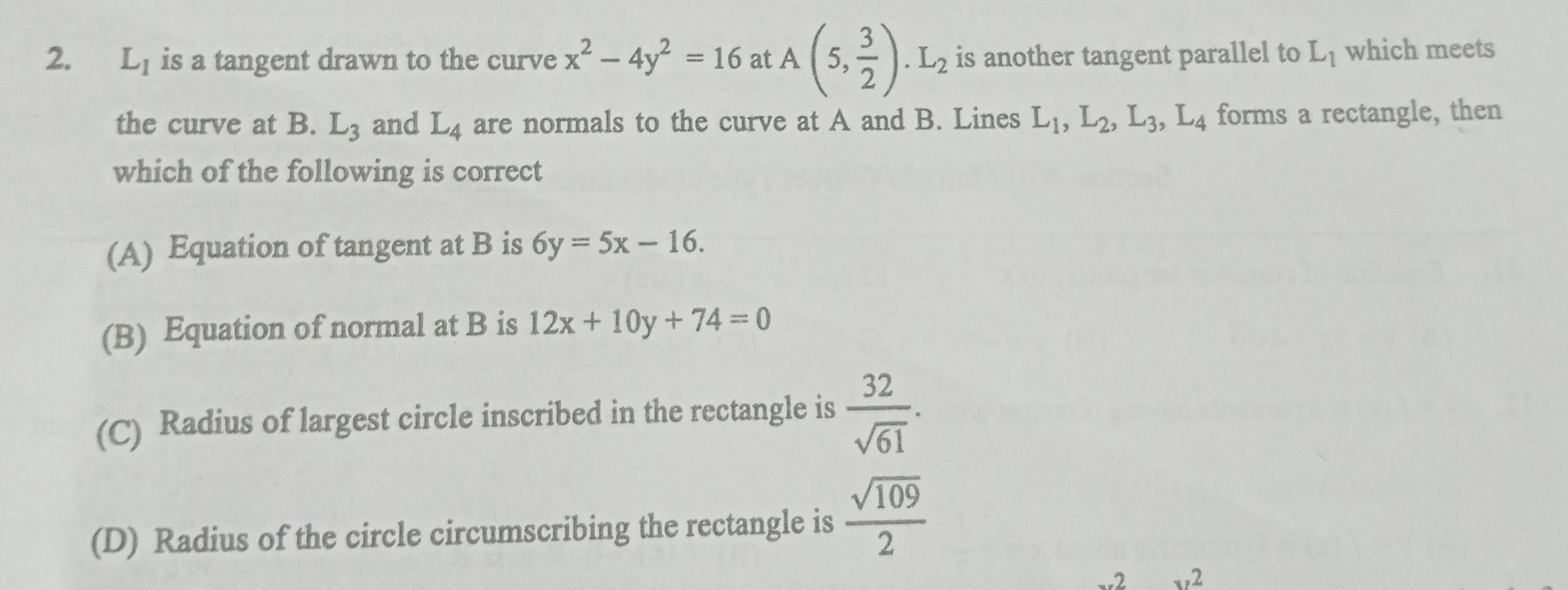Question
Question: $L_1$ is a tangent drawn to the curve $x^2 - 4y^2 = 16$ at $A(5, \frac{3}{2})$. $L_2$ is another ta...
L1 is a tangent drawn to the curve x2−4y2=16 at A(5,23). L2 is another tangent parallel to L1 which meets the curve at B. L3 and L4 are normals to the curve at A and B. Lines L1,L2,L3,L4 forms a rectangle, then which of the following is correct

Equation of tangent at B is 6y=5x−16.
Equation of normal at B is 12x+10y+74=0
Radius of largest circle inscribed in the rectangle is 6132.
Radius of the circle circumscribing the rectangle is 2109
Radius of the circle circumscribing the rectangle is $\frac{\sqrt{109}}{2}
Solution
The given curve is a hyperbola x2−4y2=16, which can be written as 16x2−4y2=1. Here a2=16,b2=4. Point A(5,23) is on the curve since 52−4(23)2=25−4(49)=25−9=16.
L1 is the tangent at A(5,23). The equation of the tangent at (x1,y1) to a2x2−b2y2=1 is a2xx1−b2yy1=1. L1:16x(5)−4y(23)=1⟹165x−83y=1⟹5x−6y=16. The slope of L1 is m1=65.
L2 is another tangent parallel to L1. Its slope is m2=m1=65. The equation of tangent with slope m is y=mx±a2m2−b2. y=65x±16(65)2−4=65x±16(3625)−4=65x±9100−4=65x±964=65x±38. The two tangents are y=65x+38 (6y=5x+16 or 5x−6y+16=0) and y=65x−38 (6y=5x−16 or 5x−6y−16=0). L1 is 5x−6y−16=0. L2 is 5x−6y+16=0. L2 meets the curve at B. The point of tangency (x1,y1) for y=mx+c is (c−a2m,c−b2). For L2:y=65x+38, m=65,c=38. xB=8/3−16(5/6)=8/3−80/6=6−80×83=2−10=−5. yB=8/3−4=8−12=−23. So B=(−5,−23).
L3 and L4 are normals at A and B. The slope of the normal is −mtangent1. Slope of L3 (normal at A): m3=−m11=−56. Equation of L3: y−23=−56(x−5)⟹10(y−23)=−12(x−5)⟹10y−15=−12x+60⟹12x+10y−75=0. Slope of L4 (normal at B): m4=−m21=−56. Equation of L4: y−(−23)=−56(x−(−5))⟹y+23=−56(x+5)⟹10(y+23)=−12(x+5)⟹10y+15=−12x−60⟹12x+10y+75=0.
The four lines are L1:5x−6y−16=0, L2:5x−6y+16=0, L3:12x+10y−75=0, L4:12x+10y+75=0. L1∣∣L2 and L3∣∣L4. m1m3=(65)(−56)=−1, so L1⊥L3. The lines form a rectangle.
Let's check the options: (A) Equation of tangent at B is 6y=5x−16. The tangent at B is L2:5x−6y+16=0⟹6y=5x+16. (A) is incorrect. (B) Equation of normal at B is 12x+10y+74=0. The normal at B is L4:12x+10y+75=0. (B) is incorrect.
(C) Radius of largest circle inscribed in the rectangle. The side lengths of the rectangle are the distances between parallel lines. Distance between L1 and L2: d1=52+(−6)2∣−16−16∣=25+3632=6132. Distance between L3 and L4: d2=122+102∣−75−75∣=144+100150=261150=6175. The diameter of the inscribed circle is min(d1,d2)=min(6132,6175)=6132. The radius is 21×6132=6116. (C) is incorrect.
(D) Radius of the circle circumscribing the rectangle. The diameter of the circumscribing circle is the length of the diagonal of the rectangle. The vertices A and B are opposite vertices of the rectangle. A=(5,23), B=(−5,−23). The distance AB is the length of the diagonal. AB=(−5−5)2+(−23−23)2=(−10)2+(−3)2=100+9=109. The diameter of the circumscribing circle is 109. The radius is 2109. (D) is correct.
